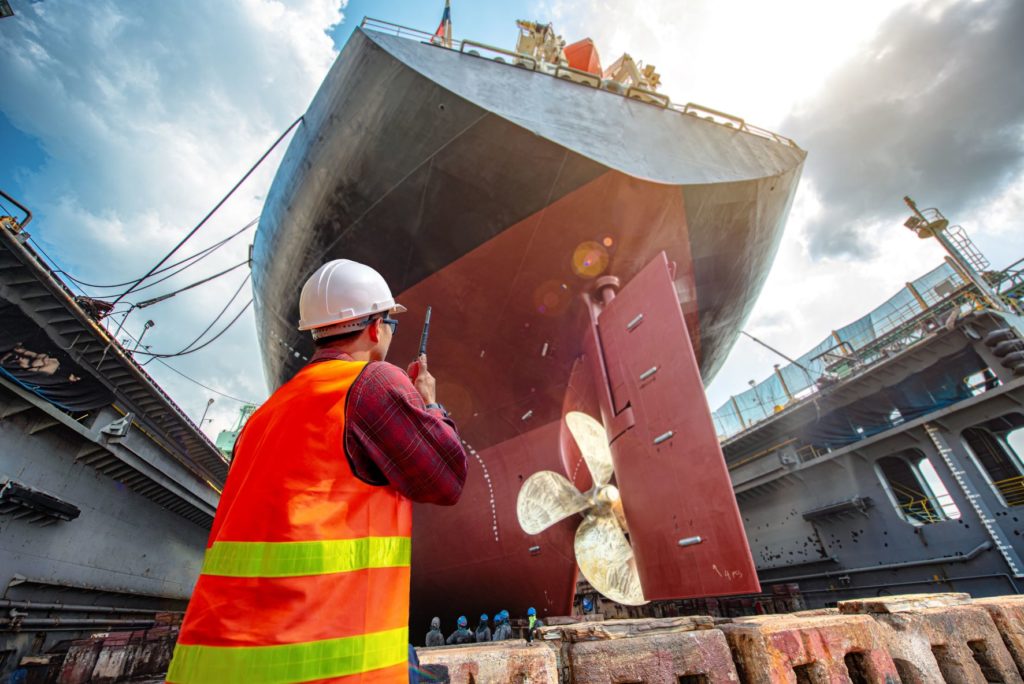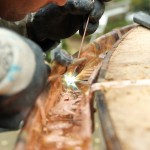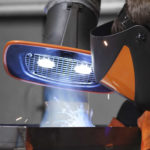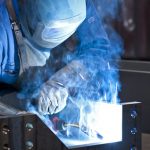Welding in shipbuilding: Important facts and protective measures
Protecting employees from hazardous substances in welding fumes: This important goal is also of central importance in shipbuilding. Whereas individual components are built in huge halls or docks, daily welding work increasingly takes place directly inside the ship, and this brings great challenges.
The exposure situation in shipbuilding is characterised by electrical hazards because the employees are surrounded by electrically conductive parts. In addition, welding work is carried out in confined spaces and with complex component geometries. Extraction at the point of origin is often difficult there. One consequence of welding in confined spaces is difficult indoor air conditions. Added to this is the physical strain: Employees often weld while kneeling or even lying down. This makes the use of appropriate personal protective measures all the more important. But it is not only the workplace that varies – in shipbuilding, a number of different welding processes are used due to the wide range of tasks.
Welding procedures and hazardous materials in shipbuilding
The welders primarily use MIG/MAG welding, manual arc welding and TIG welding. They use the processes to carry out joint welding on steel or aluminium materials, among other things.
Together with the confined working space on ships, the hazardous substances create challenges. To ensure the occupational safety of employees, the STOP principle for welding work in general represents an important reference point for the implementation of appropriate measures. Accordingly, four steps must first be followed:
- Substitution: Priority should be given to welding processes with low emission rates.
- Technical protective measures: Due to the confined space, welders mainly rely on high-vacuum extraction systems. Due to their small hose diameter, they can also be used in extremely confined spaces. The comparatively low volume flows require smoke collection as close as possible to the welding point. In this case, torch extraction is the best option, as the extraction openings are integrated in the welding torch.
- Organisational protective measures: Access restrictions or time limits for welding work can help avoid unnecessary hazards from welding fumes. For example, during welding work inside a ship, such as in the double hull, only those persons who are welding or secure a welder should be present (access restriction). This avoids unnecessarily endangering those people who are not involved. The same effects can be achieved by limiting the duration of highly emitting work.
- Personal protection measures: If the immediate technical and organisational measures are not sufficient to protect welders at work, personal protective measures such as respiratory protection are used. Due to the complicated circumstances, these measures are particularly important for the safety of employees in shipbuilding. Working with respiratory protection is the rule rather than the exception.
Materials in shipbuilding
A wide variety of materials are used in shipbuilding, depending on the type of ship and its use. A submarine makes completely different demands on the material and construction than a cargo ship, and in this respect, too, a tanker differs significantly from a freighter for bulk goods or containers. Large ocean-going vessels for cargo or cruise ships with all the facilities for hotel operations and entertainment, including wellness areas, present yet other challenges.
Structural steels are mainly used for the structural part. For the entire technical equipment, different materials are used depending on the intended use, sometimes with particularly high strength, sometimes with special corrosion resistance. Accordingly, different welding processes are used for welding work as well as different filler materials. Above all, they have one thing in common: The fumes released from the welding range in effect from lung-damaging to carcinogenic and pose a health hazard to the welder as well as other workers.
The hazardous substances and unusual spatial conditions make welding work in shipbuilding distinctive: It is different from work in other sectors and fields. The welders work in a forced position in the ship’s double hull. This stress is compounded by the often difficult ventilation situation. These areas are ventilated by extraction and air supply using hoses and fans. The daily work is more exciting and varied, but more hazardous – at least without the right protective equipment.
Proven protective measures in shipbuilding
In shipbuilding, too, the greatest importance in protecting against welding fumes is certainly attached to technical measures such as extraction directly at the welding torch and the ventilation of rooms. Personal protective measures are also often required in shipbuilding. These include in particular:
- Fan assisted welding helmets
Welding helmets with fan support draw in the room air in a less polluted area, usually at the back of the employee. The welding fumes are separated in a high-quality filter and the clean air is then blown into the protective helmet by an adjustable blower via a hose connection. The airflow is adapted to breathing thanks to advanced technology.
- Welding helmets with external compressed air supply
Welding helmets with a compressed air supply are a suitable alternative. These helmets do not draw in air, unlike the fan-assisted version. Instead, fresh air is fed into the sealed head shield. The air creates an overpressure there, thus preventing the penetration of welding fumes. This makes the welder independent of the quality of the air in the room, and such helmets are therefore also suitable for protection against gaseous substances or in the case of reduced oxygen concentration in confined spaces.
- FFP3 filtering respirators
Protection class FFP3 masks filter at least 99 percent of harmful particles by means of an integrated filter.
Recommendations for the choice of personal respiratory protection
The multitude of possible protective measures can pose major challenges for employers: How do I best protect my employees? Which measures are effective? If the measures according to the first three letters of the STOP principle are not possible or not sufficient on their own, personal respiratory protection is recommended. For orientation, here are a few more tips:
- Ventilation measures should be set up first.
- If this is not possible for reasons of space, welders are equipped with ventilated hoods or helmets. They are suitable for longer periods of wear because they compensate for breathing resistance with the help of the blower support.
- If nitrous gases occur, filter class NO-P3 masks are required.
- If there is a risk of oxygen deficiency, self-contained breathing apparatus must be used.






